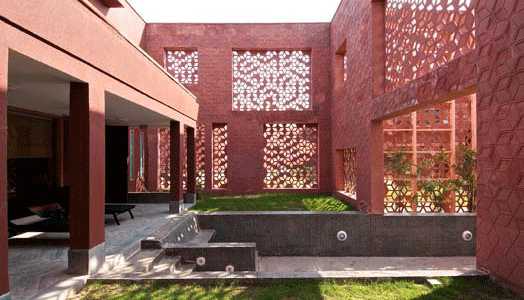Hospitality Design Special
Info
& Images: Courtesy Urban Studio
 |
| Courtyards |
Drawing
from contextual elements of Rajasthani architecture and culture, Ar. Pronit
Nath designs Le Bua Villas at the Devi Ratna, Jaipur…
Combining
the aesthetics of the present with the emotional values of the past, and taking
a cue from the vivid colour palette of the Navratn (nine gems), and the
traditional architecture of Rajasthan with its signature jhoolas (swings) and
jaalis (trellis), Ar. Pronit Nath of Urban Studio, Mumbai uses meticulous
craftsmanship and intricate artistry as the precursors for a signature
hospitality experience.
.jpg) |
| Villa Facade |
Exuding
an aura of royal vintage, two aspects at the forefront of the design are the
bold colour scheme that gives the project its unique colour coding and rich
contextual climate integral to the Rajasthani way of life.
.gif) |
| Villa Interiors |
As if
cocooned within the traditional secure shell reminiscent of old havelis and
chowks, a material palette of vivid colours like Emerald green, Ruby red,
orange Coral, yellow Sapphire and corresponding
stones like Agra red, Bheslana marbles, sandstones and slates combine
with hammered metal, leafing, mirror work to interpret the ‘Navratn’ in the
interior spaces. Yet, far from being a riot of colour, most spaces are
monochromatic with shades and tones of the same colour bathing guests in a pool
of serenity, with traditional leheriya
textile patterns are reinterpreted to create inlay stone carpets and insitu
floors. Predominant are compositions in
hues of gold, silver and copper.
.jpg) |
| Jaalis |
Jaalis
or privacy screens are used prolifically and with varying tessellations to
respond to programmatic needs. The composition is interspersed with a series of
courtyards that provide spaces of convening and chance interactions, and also
serve to cool the space around. The scale, density, and porosity change with reference
to context but their original hand-carved nature prevails. The jaali therefore
becomes the skin of the entire project giving the facades much of their
elegance.
.jpg) |
| Amer fort wall |
Despite
the traditional ethos, contemporary patterns constitute an eclectic vocabulary
throughout the project - ranging from the architectural scale of floors, walls,
facades, jaalis to the interior and product scale of accessories, cutlery and
textiles. Like the iconic pattern of the Amer fort wall transposed on the glass
façade of the pool restaurant, articulating the façade and creating visual
layering, transparency, and luminosity that is reflected in the blue waters of
the pool.
.gif) |
| Grill detail by the poolside cafe |
By
varying the spacing and thickness, changes in scale and perception are created.
“Our primary intent was to insert devices that would give every space its
unique personality. These
devices-formal, material or programmatic become anchors of each space and
eventually form the visual vocabulary for the entire project,” says Pronit.
A prime
reason why the Le Bua villas are a haven of privacy and warmth cocooned in the
cultural and traditional ethos of the place; yet transcending it to form their own
contemporaneity and expression in 21 century India.

Nice post, I bookmark your blog because I found very good information on your blog, Thanks for sharing more information
ReplyDeleteIt's beautiful detail, such as the grillwork, within modern framing.
ReplyDeleteGood ..... Actually best architectural work .... After all its combo of old with new
ReplyDelete